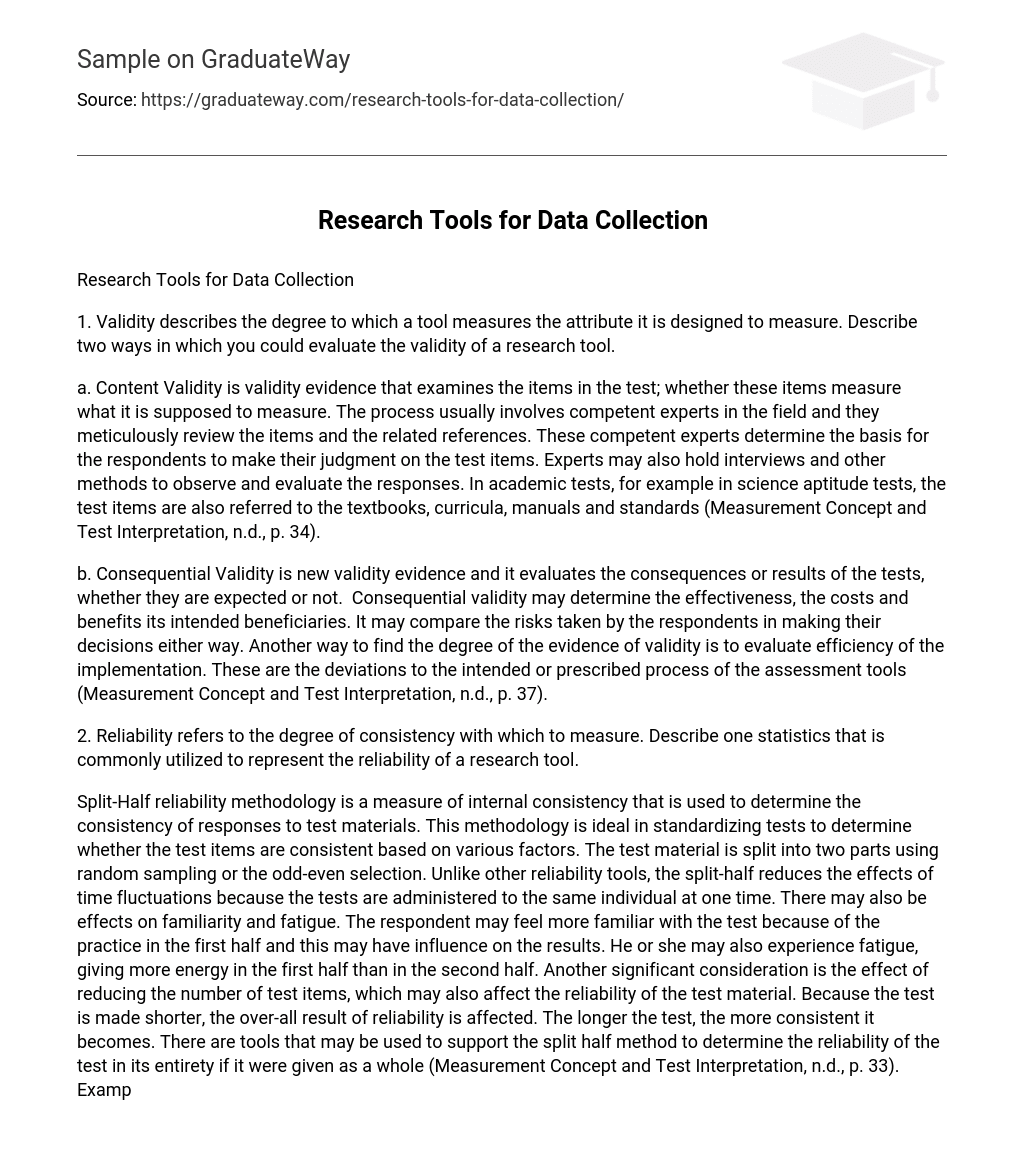1. Validity describes the degree to which a tool measures the attribute it is designed to measure. Describe two ways in which you could evaluate the validity of a research tool.
a. Content Validity is validity evidence that examines the items in the test; whether these items measure what it is supposed to measure. The process usually involves competent experts in the field and they meticulously review the items and the related references. These competent experts determine the basis for the respondents to make their judgment on the test items. Experts may also hold interviews and other methods to observe and evaluate the responses. In academic tests, for example in science aptitude tests, the test items are also referred to the textbooks, curricula, manuals and standards (Measurement Concept and Test Interpretation, n.d., p. 34).
b. Consequential Validity is new validity evidence and it evaluates the consequences or results of the tests, whether they are expected or not. Consequential validity may determine the effectiveness, the costs and benefits its intended beneficiaries. It may compare the risks taken by the respondents in making their decisions either way. Another way to find the degree of the evidence of validity is to evaluate efficiency of the implementation. These are the deviations to the intended or prescribed process of the assessment tools (Measurement Concept and Test Interpretation, n.d., p. 37).
2. Reliability refers to the degree of consistency with which to measure. Describe one statistics that is commonly utilized to represent the reliability of a research tool.
Split-Half reliability methodology is a measure of internal consistency that is used to determine the consistency of responses to test materials. This methodology is ideal in standardizing tests to determine whether the test items are consistent based on various factors. The test material is split into two parts using random sampling or the odd-even selection. Unlike other reliability tools, the split-half reduces the effects of time fluctuations because the tests are administered to the same individual at one time. There may also be effects on familiarity and fatigue. The respondent may feel more familiar with the test because of the practice in the first half and this may have influence on the results. He or she may also experience fatigue, giving more energy in the first half than in the second half. Another significant consideration is the effect of reducing the number of test items, which may also affect the reliability of the test material. Because the test is made shorter, the over-all result of reliability is affected. The longer the test, the more consistent it becomes. There are tools that may be used to support the split half method to determine the reliability of the test in its entirety if it were given as a whole (Measurement Concept and Test Interpretation, n.d., p. 33). Examples of these are the “Spearman Brown Prophecy Formula” and the “Cronbach’s Alpha” (Types of Reliability, 2006, p. 1).
3. Assessment tools. Identify five tools commonly used in Chronic Depression in adults.
Some assessment tools recommended for older patients with Chronic Depression:
a. Patient Health Questionnaire (PHQ-9). A nine-item questionnaire based on DSM IV used to diagnose and evaluate the level of depression. It categorizes the levels as minimal, mild, moderate, moderately severe and severe depression.
b. Hospital Anxiety and Depression Scale (HADS). Five-minute duration test to assess anxiety and depression. Scales are classified as normal, mild, moderate and severe.
c. Beck Depression Inventory 2nd Edition (BDI-II). Using DSM IV criteria, also a five-minute test assessing the how severe the level of depression and can be used both normal and clinical patients. It is graded minimal, mild, moderate and severe.
d. Geriatric Depression Scale. This tool is very suitable for older patients.
e. Cornell Scale for Depression. Suitable for patients with Dementia. (Laurence, 2008).
4. Describe three disadvantages associated with the use of assessment tools for gathering information on the client.
In the development, implementation and interpretation of psychological tests, it is understood that: a. Assessment tools are not perfect. Because of the innate qualities of humans, tests cannot provide exact results but will have to rely on closest, most reliable interpretations. b.
testing for validation and reliability of tests is a continuous process. The test will have to be revalidated to match its effectiveness based on many factors. c. because the processes are long and tedious, to be used for specific and limited coverage may turn out to be too expensive for implementation (Measurement Concept and Test Interpretation, n.d.).
References
Knott, Laurence. (2008). “Recognising and Screening for Depression in Primary Care”. Patient UK. Retrieved 10 January 2008 from http://www.patient.co.uk/showdoc/40024566/
“Measurement Concept and Test Interpretation” (n.d.). Basic Concepts of Psychological Assessment. Chapter 3. pp. 23-38.
“Types of Reliability” (2006). Research Methods Knowledge Base. Retrieved 10 January 2009 from http://www.socialresearchmethods.net/kb/reltypes.php





